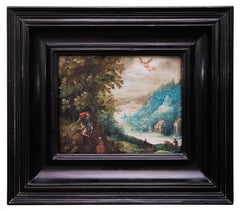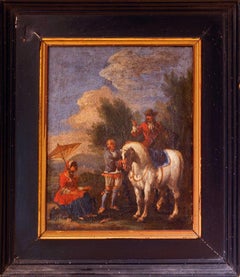Willem van Nieulandt II Art
Dutch, 1584-1635
Willem van Nieulandt II was a pupil of Roelant Savery in Amsterdam, and he left him to travel to Rome, where he became a student of Paul Bril. He specialized in painting artistic ruins of monuments, arches and temples, many of which he then engraved himself. He returned to Amsterdam (via Antwerp) in 1607, and became a respected poet there as well as Italianate painter. At some point after May 1629, he returned to Amsterdam, where he lived until his death in 1635.
to
1
1
Overall Width
to
Overall Height
to
1
1
1
1
1
1
9,514
2,688
1,375
1,361
1
1
Artist: Willem van Nieulandt II
Laban Demanding the Return of the Teraphim from Rachel - Dutch Old Master art
By Willem van Nieulandt II
Located in Hagley, England
This very busy oil on panel is a Dutch Old Master painting dating to around 1620 by artist and poet Willem van Nieulandt. It is an incredibly detailed and colourful scene composed of...
Category
17th Century Old Masters Willem van Nieulandt II Art
Materials
Oil
Related Items
Abraham and the Sacrifice of His Son Isaac by Adriaen Van Stalbemt, C. 1605-1610
Located in Stockholm, SE
Artist: Adriaen van Stalbemt (Stalbempt) 1580-1662
Title: Abraham and the Sacrifice of His Son Isaac “Das Opfer des Abraham”
According to the Old...
Category
Early 1600s Old Masters Willem van Nieulandt II Art
Materials
Copper
The Knight - painting - XVII century
Located in Roma, IT
The Knight is an original oil painting on canvas realized during the XVII century by an anonymous artist.
Provenance: Pecci-Blunt collection. Good condition...
Category
17th Century Old Masters Willem van Nieulandt II Art
Materials
Canvas, Oil
Antique Roman painter - 18th century landscape painting - Wanderers - Italy
Located in Varmo, IT
Roman painter (18th century) - Landscape with Wayfarers.
43.5 x 34.5 cm unframed, 58.5 x 49.5 cm with frame.
Ancient oil painting on canvas, in a carved and gilded wooden frame (no...
Category
Early 18th Century Old Masters Willem van Nieulandt II Art
Materials
Canvas, Oil
$1,185 Sale Price
44% Off
H 23.04 in W 19.49 in
19th Century Roman Landscape oil on canvas with Giltwood Frame
Located in Rome, IT
Amaizing 19' century Roman landscape depicting a part of Villa Borghese with Trinità dei Monti.
With a finely carved gilt wood coeval frame.
Measurements with frame cm 65 x78 wit...
Category
19th Century Old Masters Willem van Nieulandt II Art
Materials
Oil
$5,335
H 25.6 in W 30.71 in D 1.97 in
Martyrdom of Saint Stephen- Painting attr. to Vincent Adriaenssen- 17th Century
Located in Roma, IT
Landscape with martyrdom of Saint Stephen is an old master artwork realized in 17th century.
Mixed colored oil painting on canvas.
Includes coeval gilded frame cm. 148x196.
The artwork is attributed to Vincent Adriaenssen called il Manciola (Antwerp, 1595 - Roma, 1675)
Among the painters who worked in the first half of the seventeenth century it is possible to indicate only the Neapolitan Scipione Compagno (1624-1680) as the author of scenes of martyrs set within a landscape or a view such as, for example, the Martyrdom of Saint Stefano recently hesitated at the Ansorena in Madrid on June 16, 2021. It should be noted, however, that the landscape represented in the painting examined here, characterized by luxuriant vegetation, meticulously represented "in the Flemish style", shows differences with the typical settings of the paintings di Compagno, characterized above all by urban views, visionary architectures or rather arid vegetation. Even the refined figures, so elongated and lanky, represented in our painting, in particular the group of knights in the foreground on the right, are not reflected in the production of the Neapolitan painter. These elements, to which we add the depiction of the Eternal Father amidst the clouds and the detail of the dog in profile in the foreground, instead recall a painter mainly known as a battle soldier, but who was also the author of many works depicting episodes from ancient Rome set within luxuriant landscapes, or rather Vincent Adriaenssen known as Manciola, a painter from Antwerp whose figure has been shed light thanks to recent studies. The group of horsemen represented to the right of the examined painting is, in fact, comparable with other groups on horseback present in numerous works by Manciola such as, for example, in the Triumph of Caesar (Rome, Babuino, 23-03-2010; formerly Florence, Collection Privata, 2006), while similar elongated and somewhat lanky figures, dressed in red, yellow, blue and white, can be found in the three paintings conserved at the Cassa di Risparmio di Pesaro, which in the past were erroneously attributed to the Umbrian painter Francesco Allegrini...
Category
17th Century Old Masters Willem van Nieulandt II Art
Materials
Oil
$37,942
H 49.22 in W 68.9 in D 0.04 in
Antique English 19th century marine scene
By William Anderson
Located in Woodbury, CT
Outstanding English late 18th / early 19th century marine scene by one of Britain's best known and sought after painters.
William (or Wiliam) Anderson (1757 – 27 May 1837) was a Scottish artist specializing in maritime and patriotic themes. He was well-regarded for his detailed and accurate portraits of ships under sail, exhibiting his works annually in London between 1787 and 1811 and then occasionally until 1834. Anderson influenced other artists, notably John Ward and others of the Hull school.
Anderson's early life is obscure, but he is known to have trained as a shipwright before moving to London to become a maritime painter when he was about 30. His training served him well as a painter, providing "a practical nautical knowledge" of his subjects. He earned a reputation for "accuracy and refinement of detail" and was admired for his bright, clear colours. He worked in both oils and watercolours.
He based his style on that of well-known Dutch maritime...
Category
1810s Old Masters Willem van Nieulandt II Art
Materials
Oil, Wood Panel
$5,962 Sale Price
25% Off
H 8 in W 10 in
Portrait of Cornelis and Michiel Pompe van Meerdervoort with Their Tutor
By Aelbert Cuyp
Located in Stoke, Hampshire
Attributed to Aelbert Cuyp (1620-1691)
An Equestrian Portrait of Cornelis (1639–1680) and Michiel Pompe van Meerdervoort (1638–1653) with Their Tutor and Coachman
Signed 'A. Cuyp. fe...
Category
17th Century Old Masters Willem van Nieulandt II Art
Materials
Oil
$28,989 Sale Price
40% Off
H 28.75 in W 36 in
19th Century English Antique, Two Country farmers drinking beer in a landscape
By George Morland
Located in Woodbury, CT
Attributed to George Morland.
19th Century English Antique, Two Country farmers drinking beer in a landscape.
Wonderful early 19th-century original oil on canvas.
A classic 'Morland' composition as the painter was a big fan of English Pub scenes...
Category
Early 1800s Old Masters Willem van Nieulandt II Art
Materials
Canvas, Oil
$3,160 Sale Price
20% Off
H 20 in W 16 in
Five mid 20th century Italian oil landscapes with figures, castles, Churchs
Located in Woodbury, CT
A very interesting set of five mid-20th-century Italian oils on copper.
All five are classical landscape subjects and are signed Roger, though we don't know which artist with the n...
Category
1950s Old Masters Willem van Nieulandt II Art
Materials
Copper
$4,517 Sale Price
35% Off
H 7 in W 5 in
19th Century Roman Landscape oil on canvas with Giltwood Frame
Located in Rome, IT
Amaizing 19' century Roman landscape depicting a part of Villa Borghese with Trinità dei Monti.
With a finely carved gilt wood coeval frame.
Measurements with frame cm 65 x78 wit...
Category
19th Century Old Masters Willem van Nieulandt II Art
Materials
Oil
$5,335
H 25.6 in W 30.71 in D 1.97 in
Christ Supported by an Angel in the Garden of Gethsemane, On Slate
Located in Stockholm, SE
This evocative Veronese School painting captures the moment in the Garden of Gethsemane when Christ, overwhelmed with sorrow, prays to God before his arrest and crucifixion. Supporte...
Category
Early 17th Century Old Masters Willem van Nieulandt II Art
Materials
Slate
$8,181
H 20.48 in W 16.15 in
The peace of your nights descends into their thoughts
Located in Genève, GE
Work on paper mounted on wood
35.5 x 45.5 x 2 cm
Category
Late 18th Century Old Masters Willem van Nieulandt II Art
Materials
Oil
Willem Van Nieulandt Ii art for sale on 1stDibs.
Find a wide variety of authentic Willem van Nieulandt II art available for sale on 1stDibs. You can also browse by medium to find art by Willem van Nieulandt II in oil paint, paint, panel and more. Much of the original work by this artist or collective was created during the 18th century and earlier and is mostly associated with the Old Masters style. Not every interior allows for large Willem van Nieulandt II art, so small editions measuring 26 inches across are available. Customers who are interested in this artist might also find the work of Sir Peter Lely, Sir Godfrey Kneller, and Giovan Battista Viola. Willem van Nieulandt II art prices can differ depending upon medium, time period and other attributes. On 1stDibs, the price for these items starts at $44,902 and tops out at $44,902, while the average work can sell for $44,902.


